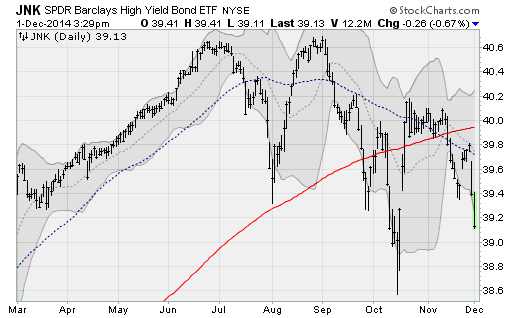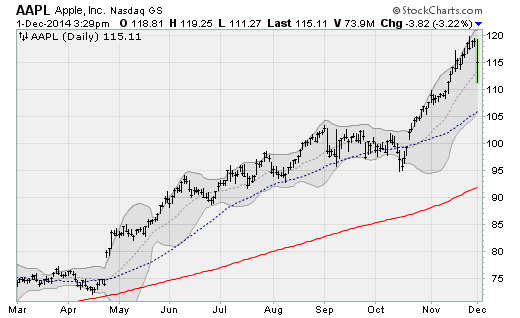December starts with scary signs for stocks
Investors have enjoyed a smooth, easy ride out of the stock market's Oct. 15 low. In fact, in terms of persistence, they've never had it better. The S&P 500 spent 29 consecutive days above its five-day moving average. And November marked the 29th consecutive month the S&P 500, on a monthly basis, closed above its five-month moving average.
But change is in the air, spurred on by the Thanksgiving Day declaration of economic war by OPEC oil ministers against the U.S. shale oil industry. That's the clear takeaway from their decision to hold oil production near current levels. Before rebounding 4.7 percent on Monday, crude oil was crushed to five-year lows near $65 a barrel, pulling down the entire energy sector on fears that with a growing share of shale production unprofitable, bond defaults and bankruptcies will follow.
Stocks felt the selling pressure on Monday after weaker-than-expected Black Friday sales and a series of disappointing reports on global manufacturing activity. The JPMorgan Global PMI has dropped to a 14-month low with U.S. factories suffering, too, unable to keep avoiding the slowdowns underway in Asia and Europe.
And, of course, now that the calendar has flipped into December, Wall Street is confronting the potential for another fiscal fight in Washington with a budget deadline on Dec. 11 (and the debt ceiling in play again in March), the Friday jobs report and the end-of-the-month Federal Reserve policy meeting.
The last two items could combine to once again remind folks that the Fed is preparing to raise interest rates sometime in the next six months or so -- something that hasn't happened since 2006.
The high-yield corporate bond market has been worrying about this for months, trading in a pattern of lower highs and lower lows since September, in sharp contrast to the ebullience stocks have demonstrated. Bond market nervousness has also manifested in the strength seen in U.S. Treasury bonds, the classic safe haven asset.
You can see the change in the way the NYSE Composite Index, my preferred measure of the stock market, has made a downward cross below its 20-day moving average for the first time since September as it contends with resistance from highs set in July and September. This is a sign of a possible downtrend starting as all the selling pressure that has been bottled up since October is suddenly unleashed.
You can see the change in the way market breadth, or the number of stocks moving to the downside vs. to the upside dropped on Monday to levels not seen since early October as investors rush for the exit.
You can see the change in the way the relationship between stocks and Treasury bonds, a sign of risk appetites, is dropping in a way not seen since late September.
And you can see the change in the way that Apple (AAPL), which on account of its persistent rise and huge market capitalization nearly single-handedly forced the market higher over the last two months, suffered a flash crash event during trading, dropping nearly 6.5 percent before recovering to end down 3.2 percent on Monday. This is a sign of fragility: The situation is so high-strung that a wave of selling orders could result in disorderly price action.
If December does turn into a dud, it'll come as a surprise to many. Historically, it's the best single month for the S&P 500, averaging a gain of 1.7 percent since 1950. And if it does turn lower, it could spell big trouble for what lies ahead in 2015.
According to Jeff Hirsch of the Stock Trader's Almanac, a precipitous market decline in December is a rare event. But when it happens, "it is usually a turning point in the market -- near a top or bottom."



